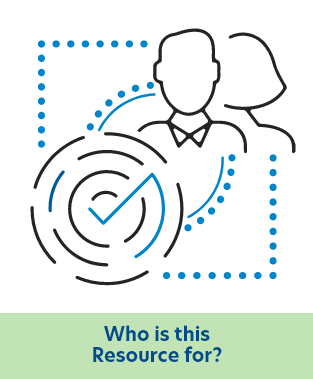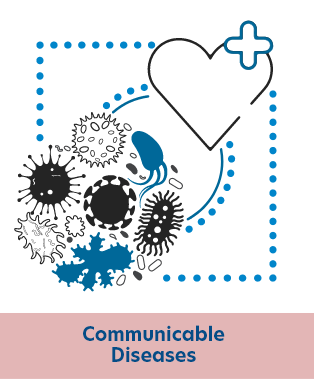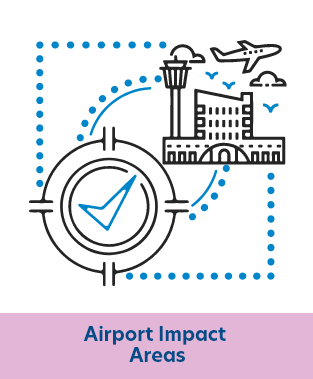
More Information
Research Tags
- Transmission: Epidemiological information about communicable disease spread in airports or public transportation (e.g., statistics, trends).
- Mitigation Measures: Evidence-based prevention or control measures of communicable diseases (e.g., face mask/social distancing for COVID-19).
- Airport Operations: How an airport and airline operate or the operational procedures that might be needed to address communicable disease threats at airports and on planes (e.g., janitorial, customer experience, facility impacts, supply inventory, amenities).
- Funding: Funding sources airports may be able to use to prepare for and respond to communicable disease threats.
- Tools: Tools to track and/or assess strategies for responding to communicable disease threats.
- Training: Training materials airports could use to respond to communicable disease threats.
- Partnerships: Ways that partners and partnerships (e.g., airlines, tenants, agencies) have been used to help plan or respond to communicable disease threats.
- Interview Candidate: Airport and/or airport contact that would be good to engage with (e.g., airport medical officer or health office).
- Case Studies/Best Practices/Innovative Initiatives: Examples from airports or relevant non-airports of minimizing the spread and impact of communicable disease (e.g., health screening, hygiene, infection control).
Glossary/Abbreviations
Direct Transmission
An infectious agent is transferred from a reservoir to a susceptible host by direct contact or droplet spread.
Direct contact
Skin-to-skin contact, kissing, and sexual intercourse.
Indirect Transmission
Transfer of an infectious agent from a reservoir to a host by suspended air particles, inanimate objects (vehicles), or animate intermediaries (vectors).
Airborne
Carried by dust or droplet nuclei suspended in air. May remain suspended in the air for long periods of time and may be blown over great distances. Airborne dust includes material that has settled on surfaces and become resuspended by air currents as well as infectious particles blown from the soil by the wind.
Vehicleborne
Passive carrying of a pathogen by food, water, biological products such as blood and fomites which include inanimate objects such as handkerchiefs.
Vectorborne (mechanical or biologic)
Passive carrying of a pathogen by hosts such as fleas, mosquitoes, and ticks.
Communicable Diseases
Communicable diseases are illnesses caused by microorganisms transmitted from one person or animal to another, usually a bacteria, virus, or parasite.
Disease Profiles
Routes of Transmission
- Respiratory: Can be transmitted by breathing in droplets that are sprayed into the air when an infected person sneezes, coughs, or talks.
- These droplets can land in the mouths or noses of individuals within close proximity (e.g., 6 feet) or possibly be inhaled into the lungs.
- Spending a lot of time in places where people share breathing space with infected individuals.
Mitigation
- Reduce exposure in small, enclosed spaces.
- Increase ventilation to reduce the concentration of infectious droplet nuclei in the air.
- Avoid air recirculation, as recirculated air can enhance the spread of infectious droplet nuclei.
- Avoid air pressure differentials between rooms, as they can increase the flow of infectious droplet nuclei to other areas.
- Avoid close contact areas by reducing proximity (e.g., social distancing) to decrease both the duration and frequency of exposures that could increase the risk for transmission.
Routes of Transmission
- Direct contact with nasal or throat secretions of infected individuals.
- Respiratory: Can be transmitted by breathing in droplets that are sprayed into the air when an infected person sneezes, coughs, or talks.
- These droplets can land in the mouths or noses of individuals within close proximity (e.g., 6 feet) or possibly be inhaled into the lungs.
- Spending a lot of time near one another where one shares breathing space.
Mitigation
- Reduce exposure in small, enclosed spaces.
- Increase ventilation to reduce the concentration of infectious droplet nuclei in the air.
- Avoid air recirculation, as recirculated air can enhance the spread of infectious droplet nuclei.
- Avoid positive air pressure that can cause disease parties to flow to other areas.
- Avoid close contact areas by reducing proximity (e.g., social distancing) to decrease both the duration and frequency of exposures that could increase the risk for transmission.
Routes of Transmission
- Respiratory: Can be transmitted by breathing in droplets that are sprayed into the air when an infected person sneezes, coughs, or talks.
- These droplets can land in the mouths or noses of individuals within close proximity (e.g., 6 feet) or possibly be inhaled into the lungs.
- Spending a lot of time near one another where one shares breathing space.
Mitigation
- Reduce exposure in small, enclosed spaces.
- Increase ventilation to reduce the concentration of infectious droplet nuclei in the air.
- Avoid air recirculation, as recirculated air can enhance the spread of infectious droplet nuclei.
- Avoid positive air pressure that can cause disease parties to flow to other areas.
- Avoid close contact areas by reducing proximity (e.g., social distancing) to decrease both the duration and frequency of exposures that could increase the risk for transmission.
Routes of Transmission
- Direct contact: sharing respiratory and throat secretions (saliva or spit).
- Respiratory: Can be transmitted by breathing in droplets that are sprayed into the air when an infected person sneezes, coughs, or talks.
- These droplets can land in the mouths or noses of individuals within close proximity (e.g., 6 feet) or possibly be inhaled into the lungs.
Mitigation
- Avoid direct mouth-to-mouth contact with infected individuals.
- Wear masks and avoid prolonged exposure to infected individuals.
Routes of Transmission
- Respiratory: Can be transmitted by breathing in droplets that are sprayed into the air when an infected person sneezes, coughs, or talks.
- These droplets can land in the mouths or noses of individuals within close proximity (e.g., 6 feet) or possibly be inhaled into the lungs.
- Spending a lot of time near one another where one shares breathing space.
- Direct contact with infected people.
- Indirect contact with surfaces in the immediate environment or with objects used on the infected person (e.g., stethoscope or thermometer).
Mitigation
- Hand hygiene: Wash your hands often with soap and water for at least 20 seconds after having contact with suspected travelers. If soap and water are not available, use an alcohol-based hand sanitizer.
- Education: Help children wash their hands by providing educational material at restroom facility locations on proper hand washing technique.
- Disinfect: Increase frequency of cleaning and disinfection of common areas and frequently touched surfaces.
- Reduce exposure in small, enclosed spaces.
- Increase ventilation to reduce the concentration of infectious droplet nuclei in the air.
- Avoid air recirculation, as recirculated air can enhance the spread of infectious droplet nuclei.
- Avoid air pressure differentials between rooms, as they can increase the flow of infectious droplet nuclei to other areas.
- Avoid close contact areas by reducing proximity (e.g., social distancing) to decrease both the duration and frequency of exposures that could increase the risk for transmission.
Routes of Transmission
- Direct contact: Transmitted primarily through the fecal-oral route, either by direct person-to-person spread or fecally contaminated food or water.
Mitigation
- Disinfect: increase frequency of cleaning and disinfection of common areas and frequently touched surfaces.
- Traveler Cohorting and Isolation Precautions: avoid exposure to vomitus or diarrhea.
- Isolate those infected in a single occupancy area.
- Hand hygiene: Encourage passengers and employees to wash their hands often with soap and water for at least 20 seconds after having contact with individuals who may be infected. If soap and water are not available, use an alcohol-based hand sanitizer.
- Education: Help children wash their hands by providing educational material at restroom facility locations on proper hand washing technique.
- Traveler Transfer and Area Closure: consider limiting transfers to those areas for which the facility personnel can maintain Contact Precautions.
Routes of Transmission
- Respiratory: Can be transmitted by breathing in droplets that are sprayed into the air when an infected person sneezes, coughs, or talks.
- These droplets can land in the mouths or noses of individuals within close proximity (e.g., 6 feet) or possibly be inhaled into the lungs.
- Spending a lot of time near one another where one shares breathing space.
- Direct contact: Individuals might also contract the flu by touching a contaminated surface or object and then touching their own mouth, nose, or possibly their eyes.
Mitigation
- Hand hygiene: Wash your hands often with soap and water for at least 20 seconds after having contact with suspected travelers. If soap and water are not available, use an alcohol-based hand sanitizer.
- Education: Help children wash their hands by providing educational material at restroom facility locations on proper hand washing technique.
- Reduce exposure in small, enclosed spaces.
- Increase ventilation to dilute or remove infectious droplet nuclei.
- Avoid air recirculation, as recirculated air can enhance the spread of infectious droplet nuclei.
- Avoid air pressure differentials between rooms, as they can increase the flow of infectious droplet nuclei to other areas.
- Avoid close contact areas by reducing proximity (e.g., social distancing) to decrease both the duration and frequency of exposures that could increase the risk for transmission.
Routes of Transmission
- Respiratory: Can be transmitted by contact with droplets that are sprayed into the air when an infected person sneezes, coughs, or talks.
- These droplets can land in the mouths or noses of individuals within close proximity (e.g., 6 feet) or possibly be inhaled into the lungs.
- Direct contact by touching an infected individual or making other close contact, like kissing, hugging, or sharing cups or eating utensils.
- Direct contact with an infected individual’s:
- Nose and throat secretions, such as saliva, drool, or nasal mucus
- Fluid from blisters or scabs
- Feces (poop) (e.g., diaper changing) followed by touching one’s eyes, nose, or mouth.
- Direct contact: touching objects and surfaces that have the virus on them, like doorknobs or toys, then touching your eyes, nose, or mouth.
Mitigation
- Hand hygiene: Wash your hands often with soap and water for at least 20 seconds after having contact with suspected travelers. If soap and water are not available, use an alcohol-based hand sanitizer.
- Always wash your hands:
- After changing diapers
- After using the toilet
- After blowing your nose, coughing, or sneezing
- Before and after caring for someone who is sick
- Education: Help children wash their hands by providing educational material at restroom facility locations on proper hand washing technique.
- Disinfect: Clean and disinfect frequently touched surfaces and shared items, including toys and doorknobs.
- Avoid touching your eyes, nose, and mouth
- Avoid close contact with sick people
Routes of Transmission
- Direct contact: contact with infected people or things that are carrying the bacteria.
- This includes contact with a contaminated wound or by sharing personal items, such as towels or razors, that have touched infected skin.
- The risk increases with activities or places that involve crowding, skin-to-skin contact, and shared equipment or supplies.
Mitigation
- Hand Hygiene: Wash your hands often with soap and water for at least 20 seconds after having contact with suspected travelers. If soap and water are not available, use an alcohol-based hand sanitizer.
- Education: Help children wash their hands by providing educational material at restroom facility locations on proper hand washing technique.
- Body hygiene: Maintain good body hygiene and clean your body regularly, especially after exercise.
- Keep cuts, scrapes, and wounds clean and covered until healed.
- Avoid sharing personal items such as towels and razors.
Additional Info
Airport Finance
Department of the Treasury COVID-19 Economic Relief: https://home.treasury.gov/policy-issues/coronavirus
Federal Aviation Administration (FAA) Grant Assurances and Obligations: https://www.faa.gov/airports/aip/grant_assurances
FAA Airports Financial Assistance Division: https://www.faa.gov/about/office_org/headquarters_offices/arp/offices/app/app500
Government Accountability Office Airport Finance Report: https://www.gao.gov/assets/gao-15-306.pdf
Airport Operations
FAA Airport Operations guide:
https://www.faa.gov/air_traffic/publications/atpubs/aim_html/
International Air Transport Association Airport Operations: https://www.iata.org/en/training/courses/airport-operations-advanced/tapp09/en/
OSHA Guidance on Preparing Workplaces for COVID-19: www.osha.gov/Publications/OSHA3990.pdf
General COVID-19 Resources
Centers for Disease Control Main COVID-19 Page: www.cdc.gov/coronavirus/2019-nCoV
Occupational Safety and Health Administration: www.osha.gov
Federal Emergency Management Agency: https://www.fema.gov/
Customer Satisfaction
J.D. Power Customer Satisfaction Survey: https://www.jdpower.com/business/press-releases/2022-north-america-airport-satisfaction-study
World Airport Survey: https://www.worldairportsurvey.com/
Airports Council International Airport Customer Experience and Survey: https://aci.aero/programs-and-services/asq/
San Francisco International Airport Customer Survey Data: https://www.flysfo.com/media/customer-survey-data
Staff Wellness
Substance Abuse and Mental Health Services Administration: https://www.samhsa.gov/
CDC Airline Guidance:
https://www.cdc.gov/quarantine/air/index.html
CDC Guidelines for Hand Hygiene in Healthcare Settings:
https://www.cdc.gov/infection-control/hcp/hand-hygiene/
International Air Transport Association Air Transport and Communicable Diseases: https://www.iata.org/en/programs/safety/health/diseases/
FAA Supervisory and Staff Guidelines: https://www.faa.gov/regulations_policies/orders_notices/index.cfm/go/document.information/documentID/6977
Customs and Border Protection COVID-19 Updates and Announcements Archive:
https://www.dhs.gov/archive/coronavirus
TSA COVID-19 Information:
https://www.tsa.gov/blog/2020/04/21/traveling-during-covid-19-pandemic
EPA List N Tool: COVID-19 Disinfectants: https://cfpub.epa.gov/wizards/disinfectants/
International Sanitary Supply Association: https://www.issa.com/
International Facilities Management Association: https://www.ifma.org/
CDC COVID-19 Information:
https://www.cdc.gov/covid/
CDC Information on Ultraviolet Germicidal Irradiation:
https://www.cdc.gov/coronavirus/2019-ncov/community/ventilation/uvgi.html
CDC Cleaning and Disinfecting your Facility:
www.cdc.gov/coronavirus/2019-ncov/community/disinfecting-building-facility.html
CDC Understanding Exposure Risks:
https://archive.cdc.gov/www_cdc_gov/coronavirus/2019-ncov/your-health/risks-exposure.html
CDC: About Handwashing:
https://www.cdc.gov/clean-hands/about/
CDC: How to Protect Yourself and Others | COVID-19:
https://www.cdc.gov/covid/prevention/index.html
American Society of Heating, Refrigerating and Air-Conditioning Engineers: https://www.ashrae.org
Stakeholder Engagement
American Association of Airport Executives: https://www.aaae.org/
Airports Council International Airport Customer Experience Accreditation: https://aci.aero/programs-and-services/asq/airport-customer-experience-accreditation/
Global Biorisk Advisory Council: https://gbac.issa.com/
Technology and Research
SKYTRAX Airline Ratings: https://skytraxratings.com/about-airline-rating
Airports Council International Airport Health Accreditation: https://aci.aero/programs-andservices/airport-operations/aci-airport-health-accreditation-program/
GBAC STAR Facility Accreditation: https://gbac.issa.com/gbac-star-facility-accreditation/
Airports Invest in Technology to Advance Industry Recovery: https://aci.aero/2021/03/11/airports-invest-in-technology-to-advance-industry-recovery/
Banner image credit: Unsplash



